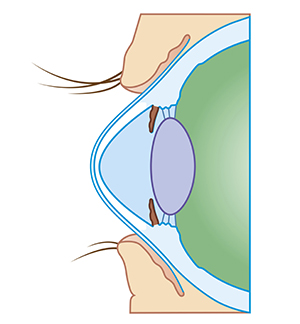
Keratoconus causes distortion of the cornea and can lead to blindness. Thin corneas are an indication of a risk of developing the disease.
© Dorling Kindersley RF/Thinkstock
The eye is covered by a clear and protective layer called the cornea, and abnormal thickness of the cornea can result in eye disease. An international research team including Chiea Chuen Khor of the A*STAR Genome Institute of Singapore has pinned down 27 genetic variations that are strongly associated with a heritable trait known as central corneal thickness (CCT). Some of these variations are also directly linked to eye diseases, so the findings may lead to better prevention and treatment.
Extreme thinning of the cornea is associated with rare eye disorders, whereas milder thinning is linked to more common problems. These include primary open angle glaucoma (POAG), which is the second leading cause of blindness worldwide, and a progressive eye disease called keratoconus, which affects 1 in 2,000 people and causes distortion of the cornea and visual impairment (see image).
In several previous studies, researchers investigated the genetic basis for CCT by comparing the corneal thickness of individuals with their genetic fingerprints. This revealed 11 genetic variations linked to CCT, but with varying levels of certainty; the new study solidified these findings and uncovered further associated genetic variations.
Khor and co-workers achieved this by collecting and re-analyzing the data from 13 previous studies as a whole. They identified a total of 27 genetic variations that are strongly linked to CCT; 16 of these had previously eluded detection. Furthermore, the researchers found that six of these variations indicated a risk of developing keratoconus, with one of the six also linked to POAG.
The new study identified a higher number of genetic variations associated with eye disease than previous ones because it included data from over 20,000 individuals. “[Our study] is three to four times the size of previous studies, and it combines data from Asians and Europeans for the first time,” explains Khor. “As such, the results are correspondingly rich in detail.”
The team’s findings not only provide greater insight into the genetic basis for corneal thinning, but also demonstrate that associated genetic variations increase the risk of common eye diseases. According to Khor, this could open up new avenues for dealing with these diseases.
“We now know the biological targets that are relevant for disease to occur, and some of these gene targets may be amenable to drug modifications,” he says. “For prevention, individuals [who carry] multiple risk variants, and who are deemed to be at very high risk of disease, can be screened earlier to intervene before blindness occurs.”
The A*STAR-affiliated researchers contributing to this research are from the Genome Institute of Singapore.



